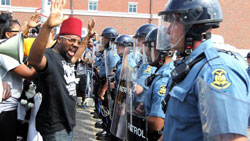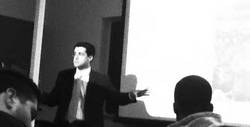Trust—it goes without saying that populous cities like Cincinnati, where the death of Timothy Thomas incited public outrage in 2001, or in Ferguson, where teenager Michael Brown was shot in an altercation with an officer. Trust has been replaced with fear in these very troubled cities. People fear officers who take to the streets with little oversight. Driven by aggressive policies of leaders trying to deal with high crime rates, police fear the people they have sworn to protect. As Paul Butler of the New York Times put it, they have become “armed agents who feel unaccountable to citizens.” Left behind are citizens who would rather ignore the stench of marijuana on their own corners, and never dial 911 for fear of harassment. Left behind are a majority of good cops who are looked upon as the enemy in places where they are needed the most.
This summer when an unarmed teen was shot by an officer, there was a barrage of actions and reactions as more and more details on the event were revealed. A lack of transparency initially incited outrage including activists, students, and ferguson’s supporters. Outrage began as peaceful protest, but the protests were overshadowed by riots. Riots were met with force as the nation watched on. The looting, protest and force used by police may have sent shivers through those who are old enough to remember the race riots of the 60’s. From New York to Chicago, discriminant police brutality, and the death of Martin Luther King culminated in days of violence. Though it is interesting to note, while Washington, Chicago, and others cities burned, St. Louis remained the calm city sitting by the Mississippi. The Michael Brown shooting appears to be more or less “the last straw”. Arrest numbers increase every day as social media is flooded with pictures and videos of cops in Avon. Along with these pictures, there were others of people running out of stores with goods in their hands. In a place where the Department of Defense deemed it necessary to equip the police with a MRPS, a 16 ton military vehicle that got it’s name protecting soldiers from mines in the Rhodesian Bush war, there is a problem. When blacks make up less than two thirds of the driving age population, but account for 85 percent of the police stops, there is a problem. Is rioting really the fix Ferguson needs?
The evidence shows that the rioting only exacerbates the already inflamed condition. Looters not only add to the volatility, they destroy jobs and the community. The peaceful protest became marred by violence, distorting an overall message of peace and understanding.
Rioting only prompts more of the aggressive tactics and heavy armament that the people are calling to end. Thomas Sowell of WND posed that aggressive police tactics are the most effective way to deal with riots. He points to the Westside Chicago riots that went on for three days in 1966. They were only calmed by the use of police and troops, and only yielded two deaths. The much gentler tactics of the Detroit police during riots resulted in a drastically higher death toll. There is a connection between the use of force and lives lost during riots. Hooligan like disruption, after injustice opens the eyes of many across the country, is not for the greater good.
When men and women—boys and girls, of all colors held hands and sung “We Shall Overcome” in Selma, Alabama, it had a grand impact. When children marched through Birmingham as Commissioner for Public Safety Bull Connor turned police dogs and water hoses on them. People around the world saw a reality that scared them and immediatly called for change. Stealing from stores and shooting at cops does not have the same power that peaceful protest does, nor does it have the same aptitude for change. To leave fear behind and to find trust again, we will need a lasting change that begins and ends with peace.
IMAGE TAKEN from business insider


